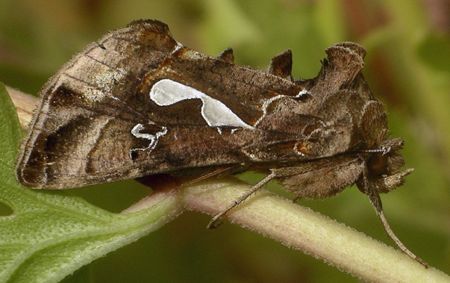by Valerie
March, 2010Bilobed Looper Moth
The majority of moths are small and brown. That does not, however, mean that they are unattractive. The bilobed looper moth (Megalographa biloba) is less than an inch long, but the intricate markings on its wings are certainly worth a closer look. As the light reflects off the scales on its wings, they sometimes produce an iridescent effect so that the insect has a slightly metallic look to it. The common and species name come from the large distinctive white mark on the forewing. The "loopers" are a group of moths including some garden pest caterpillars. The name refers to the way the larvae move; they are missing two pairs of middle legs and thus crawl like inchworms, looping their back end up towards the front. They are not, however, true inchworms. Those belong to the family Geometridae and their caterpillars have only two pairs of legs at the back end. These loopers have three pairs of rear legs and are in the family Noctuidae. They generally look like fat green worms with small heads. Because this is a nocturnal moth, it spends the day remaining still, relying on camouflage to protect it from predators. The wing markings and tufts of hair on the back help break up its outline and also blend in well with wood or stones. When the night temperatures are very cold, usually in the autumn but sometimes also in the early spring, this species and related moths will occasionally be glimpsed as they feed at flowers during the day. Their wings move so quickly that they are blurred, but they are easy targets for feasting birds. |